Crispy, golden, and packed with flavor, plantain chips are the perfect snack or side dish for any occasion. Whether you love them sweet or savory, these crunchy delights bring a delicious twist to your meals. From classic salted chips to bold, spiced variations, this guide will show you how to make and enjoy plantain chips like a pro!
Table of contents
- What Are Plantain Chips?
- Essential Ingredients for Plantain Chips
- How Plantain Chips Are Made
- Health Benefits of Plantain Chips
- The Global Appeal of Plantain Chips
- How to Enjoy Plantain Chips
- How to Store Plantain Chips
- Common Mistakes to Avoid When Making Plantain Chips
- What to Serve with Plantain Chips
- Frequently Asked Questions
- Conclusion
What Are Plantain Chips?
Introduction to Plantain Chips
Plantain chipsever had them? If you have, you probably know just how addictive these crunchy snacks can be. If not, you’re in for a treat! Think of them as the tropical cousin of potato chips but with a flavor twist that’s hard to beat. Made from plantains, which are close relatives of bananas, these chips pack a punch of natural sweetness or savoriness depending on how they’re prepared.
Plantain chips have roots in various cultures, particularly in tropical regions like Africa, the Caribbean, and Latin America. People there have been munching on these snacks for centuries, and it’s no wonder they’re not only delicious but also versatile. Whether served as a snack, a side dish, or an appetizer, they’re a winner every time.
Difference Between Plantains and Bananas
Let’s clear up a common misconception: plantains and bananas aren’t the same thing. Sure, they look alike, but they’re as different as night and day in taste and use. Think of bananas as the sweet and soft sibling, perfect for smoothies and quick snacks. Plantains, on the other hand, are the rugged adventurer of the family starchier, firmer, and made for cooking.
Plantains come in two main varieties: green (unripe) and yellow (ripe). Green plantains are less sweet and are typically used to make savory chips, while yellow plantains are sweeter and ideal for dessert-like snacks.
“Plantains are like the tough cousin of bananas. You wouldn’t eat one raw, but when cooked, they’re absolute gold!”
Essential Ingredients for Plantain Chips
To make crispy and flavorful plantain chips, you’ll need just a few simple ingredients. Here are the essentials:
1. Green Plantains (2-3 plantains)
- The key ingredient! Green plantains are firm and starchy, making them perfect for crunchy chips. Ripe plantains can be used for a sweeter version.
2. Cooking Oil (2 tbsp)
- Best choices: Olive oil, coconut oil, or avocado oil for baking.
- For frying: Vegetable oil or peanut oil works well for an even crisp texture.
3. Salt (to taste)
- Enhances the natural flavors of the plantains. Sea salt or pink Himalayan salt adds a nice touch.
4. Seasonings (optional, for extra flavor)
- Savory options: Garlic powder, smoked paprika, chili powder, black pepper.
- Sweet options: Cinnamon, nutmeg, or a light drizzle of honey after baking.
These simple ingredients create delicious, crispy plantain chips that can be customized to your taste!
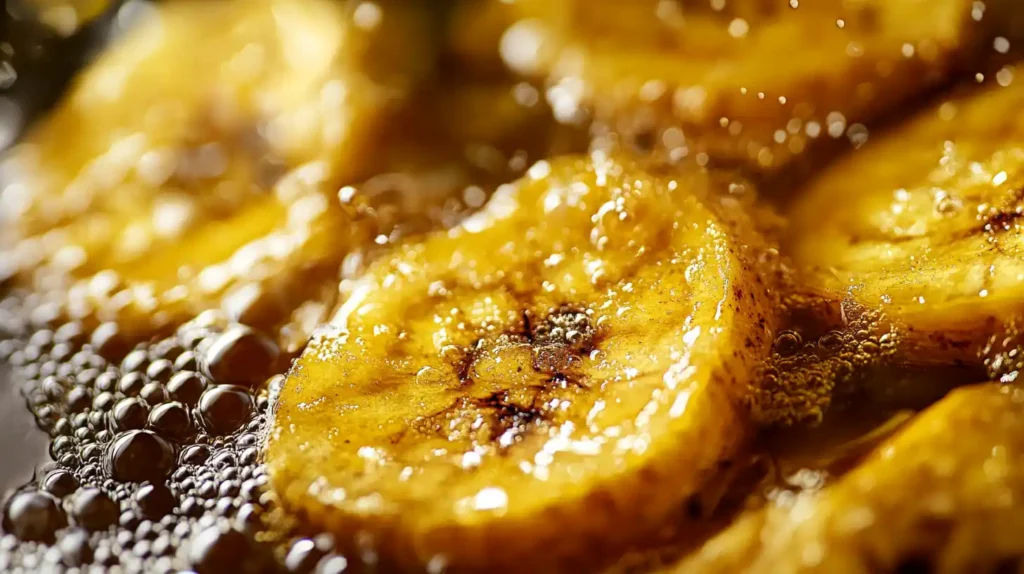
How Plantain Chips Are Made
Making plantain chips is like turning raw potential into crispy perfection. It’s a process that combines tradition with a touch of culinary magic. Here’s how it’s done:
- Selection of Plantains:
It all starts with choosing the right plantains. Green plantains are the go-to for chips because they’re firmer and hold up better during frying or baking. - Peeling the Plantains:
Peeling a plantain isn’t as simple as peeling a banana. You’ll need a knife to score the peel and separate it from the flesh. A little tricky, but totally worth it! - Slicing:
The plantains are then sliced thinly into rounds or diagonals, depending on the desired shape. Thin slices ensure that perfect crunch. - Cooking:
The slices are either fried in oil for a golden crisp or baked for a healthier twist. During frying, seasonings like salt, chili, or garlic powder can be added for extra flavor. - Packaging:
Once cooked, the chips are cooled and packed, ready to bring joy to snack lovers around the world.
Nutritional Table for Plantain Chips
Plantain chips are not just tasty they have a nutritional story to tell. Here’s a snapshot:
| Nutrient | Quantity (per 100g) |
|---|---|
| Calories | 365 kcal |
| Carbohydrates | 58g |
| Protein | 2g |
| Fat | 15g |
| Fiber | 4g |
| Potassium | 499mg |
Health Benefits of Plantain Chips
Nutritional Profile of Plantain Chips
Plantain chips are a snack that delivers more than just crunch. Thanks to their nutrient-rich base, plantains, they offer a variety of health benefits. While they’re not superfoods, they pack a decent amount of fiber, potassium, and energy-providing carbohydrates.
Let’s break it down: plantain chips are typically high in carbs, making them an excellent energy source. They also contain small amounts of protein and healthy fats, depending on how they’re prepared. If fried, the fat content is higher; if baked, you’re looking at a lower-calorie option.
Health Benefits
1. Great Source of Energy
Because of their carbohydrate content, plantain chips are an excellent snack for quick energy. Think of them as your go-to pick-me-up during a busy day or as a pre-workout fuel.
2. Digestive Support
The fiber in plantains can help keep your digestive system running smoothly. It’s like a gentle broom for your gut, sweeping out the unnecessary and promoting a healthy system.
3. Rich in Potassium
Plantain chips are a great source of potassium, an essential mineral for maintaining muscle function and heart health. Athletes often turn to bananas for potassium, but plantain chips provide a delicious alternative.
4. Immune Boosting
Plantains contain vitamin C, which helps bolster the immune system. While frying can reduce this vitamin’s potency, baked plantain chips retain more of their nutritional benefits.
Are Plantain Chips Healthy for You?
The answer is it depends! If you’re munching on fried plantain chips regularly, you might want to limit your intake because of the higher calorie and fat content. Baked plantain chips, however, are a healthier choice. These chips maintain the natural goodness of plantains while using less oil.
The Global Appeal of Plantain Chips
Origins and Cultural Significance
Plantain chips are more than just a snack they’re a cultural staple in many regions around the globe. From Africa to the Caribbean, plantains play a starring role in traditional cuisine. In these regions, plantains are seen as a versatile ingredient used in everything from stews to desserts and, of course, chips.
In places like Ghana and Nigeria, plantain chips are sold as street food, loved for their satisfying crunch and subtle sweetness. Similarly, in countries like Colombia and the Dominican Republic, plantain chips, or “tostones,” are often served alongside main dishes or as appetizers.
Popular Brands and Regional Favorites
Several brands have made a name for themselves by selling plantain chips. Some focus on the authentic taste of traditional recipes, while others experiment with flavors. Let’s take a look:
- Chifles: Known as one of the oldest and most trusted plantain chip brands in the U.S.
- Barnana: Famous for its organic and sustainably sourced chips.
- Artisan Brands: Many small, local producers bring authentic regional flavors to their offerings.
Differences Between Plantain and Banana Chips
While plantains and bananas are closely related, their chips are worlds apart. Here’s a quick comparison:
- Texture: Plantain chips are firmer and crunchier, while banana chips are often softer.
- Taste: Plantain chips have a savory or mildly sweet flavor, whereas banana chips are distinctly sweet.
- Preparation:These chips are often fried or baked with spices, while banana chips are usually sweetened and dried.
This difference boils down to how plantains and bananas are used in their raw form plantains need cooking, while bananas can be eaten raw.
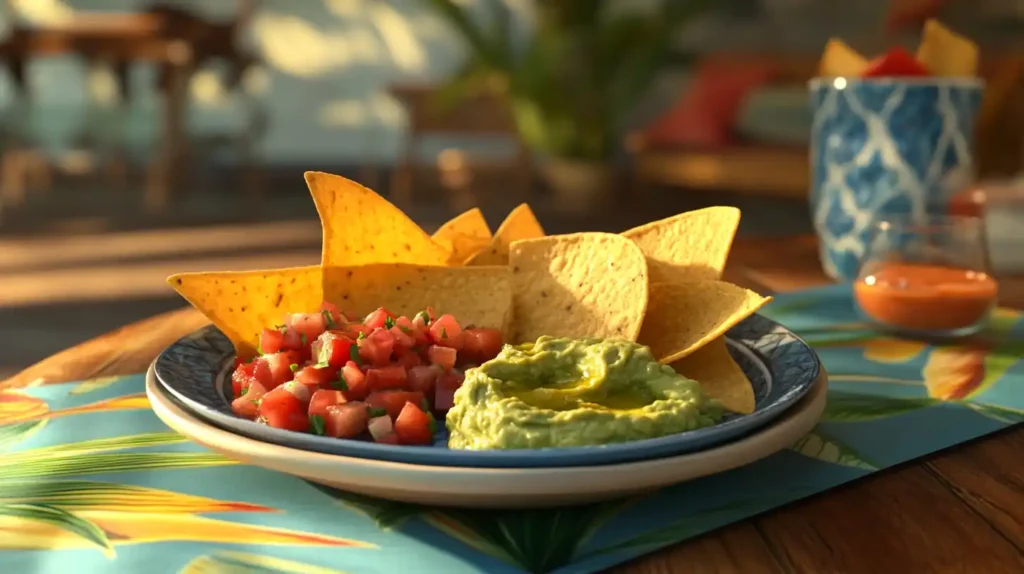
How to Enjoy Plantain Chips
Pairing Plantain Chips with Other Foods
These chips are like the little black dress of snacks they go with everything! Whether you’re throwing a party or just having a quiet snack session, there’s a way to elevate them from simple to sensational.
- Classic Dips:
Pair your chips with guacamole, hummus, or salsa for a flavor-packed combo. The crunch of the chips complements the creaminess of these dips, creating a balanced texture. - Cheesy Delights:
Have you ever tried these chips with queso or melted cheddar? The salty and savory flavors blend beautifully for an indulgent treat. - Sweet Pairings:
For those with a sweet tooth, drizzle a bit of caramel or honey over your chips. The subtle sweetness of the chips works surprisingly well with these toppings. - Meal Sides:
These chips aren’t just for snacking they can be a great side dish for meals like grilled chicken or fish. Their subtle flavor enhances the main course without overpowering it.
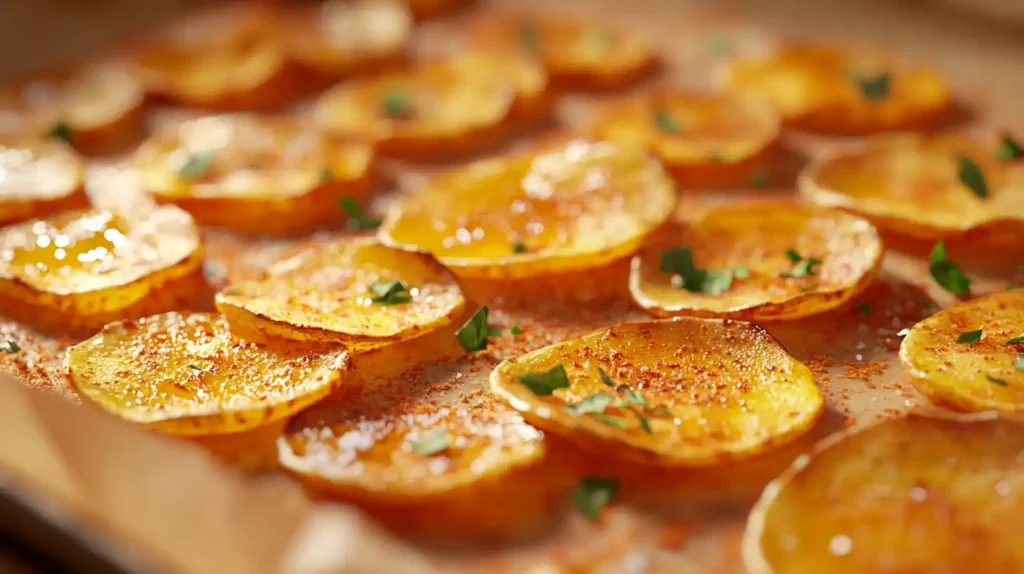
DIY Plantain Chips Recipes
If you love cooking, why not make these chips at home? It’s simple, fun, and lets you control the flavors and ingredients. Here’s a basic recipe to get you started:
- Ingredients:
- 2 green plantains
- 2 tablespoons of olive oil or coconut oil
- Salt and seasonings (like paprika or garlic powder)
- Instructions:
- Start by peeling the plantains and slicing them thinly.
- Toss the slices in oil and your chosen seasonings.
- Arrange them in a single layer on a baking sheet.
- Bake at 375°F (190°C) for 15-20 minutes, flipping once halfway through.
- Pro Tips:
- For extra crispiness, use a mandoline slicer to ensure even thickness.
- Experiment with spices like cinnamon for sweet chips or chili powder for a spicy kick.
Low-Carb Alternatives and Customizations
For those on a low-carb diet, traditional options might not fit perfectly into your macros. However, you can adapt the recipe to suit your needs:
- Use Ripe Plantains:
Ripe plantains have a slightly lower starch content, and their natural sweetness can reduce the need for sugary dips or toppings. - Air Fryer Option:
Skip the heavy frying by using an air fryer. It reduces the oil content while still delivering that satisfying crunch.
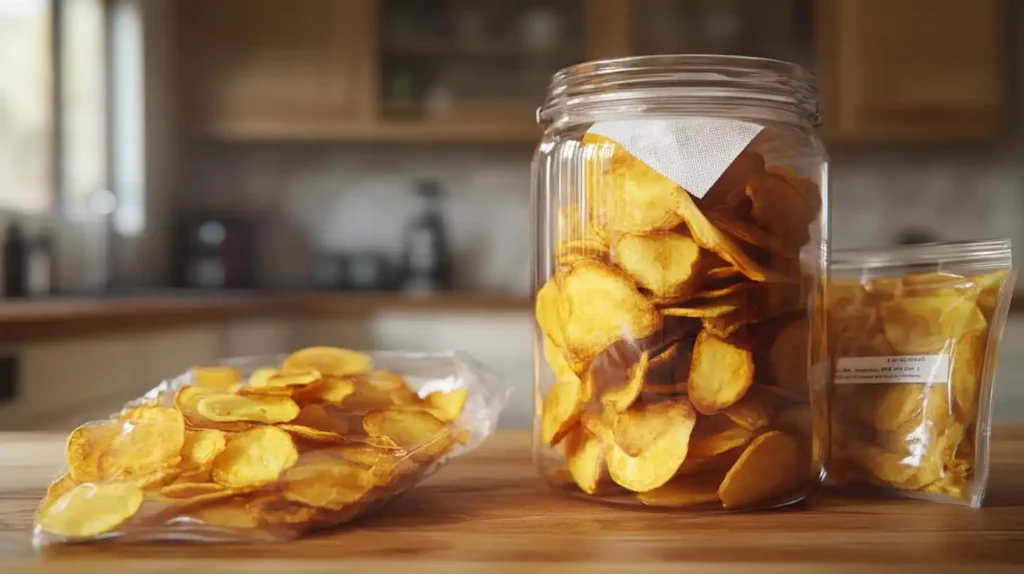
How to Store Plantain Chips
To keep your plantain chips fresh and crispy for as long as possible, follow these storage tips:
1. Use an Airtight Container
- Store your chips in an airtight container or a resealable plastic bag to prevent moisture from making them soggy.
- Glass or plastic containers with tight-fitting lids work best.
2. Keep Them at Room Temperature
- Store the container in a cool, dry place away from direct sunlight and humidity.
- Avoid keeping them near heat sources like stoves or ovens, as excess warmth can make them stale faster.
3. Add a Paper Towel for Freshness
- Placing a paper towel inside the container can help absorb any excess moisture, keeping the chips crisp for longer.
4. Don’t Refrigerate
- Refrigeration can introduce moisture and make the chips lose their crunch. Room temperature storage is best.
5. Freeze for Long-Term Storage (Optional)
- If you need to store them for several weeks, you can freeze them.
- Place the chips in a freezer-safe bag, removing as much air as possible before sealing.
- To re-crisp, bake them in the oven at 300°F (150°C) for 5–7 minutes before serving.
6. Consume Within 5–7 Days
- For the best taste and texture, enjoy your plantain chips within one week of making them.
By following these steps, you can keep your homemade plantain chips crunchy and delicious for days!
Common Mistakes to Avoid When Making Plantain Chips
Even with the right ingredients, small missteps can affect the final result. Here are some common mistakes to watch out for:
1. Using Overripe Plantains
- Mistake: Using yellow or fully ripe plantains can result in soft, soggy chips instead of crispy ones.
- Solution: Stick to green plantains for the best crunch.
2. Slicing Too Thick or Too Thin
- Mistake: Thick slices take longer to cook and may be chewy, while ultra-thin slices can burn easily.
- Solution: Aim for uniform, thin slices (about 1/8 inch thick) for even cooking and crispiness. A mandoline slicer helps with precision.
3. Not Drying the Plantains Before Cooking
- Mistake: Excess moisture can cause uneven cooking and prevent a crispy texture.
- Solution: Pat the slices dry with a paper towel before frying or baking.
4. Overcrowding the Pan or Baking Sheet
- Mistake: Piling the slices on top of each other leads to uneven cooking and soggy chips.
- Solution: Arrange the slices in a single layer with space between them for proper airflow and crisping.
5. Not Flipping or Stirring
- Mistake: Failing to flip chips halfway through cooking can lead to uneven browning.
- Solution: Flip them once during baking or stir them while frying for consistent crispiness.
6. Skipping the Seasoning Step
- Mistake: Adding salt and seasonings too late means they won’t stick well to the chips.
- Solution: Season immediately after frying or before baking for the best flavor absorption.
7. Cooking at the Wrong Temperature
- Mistake: Too low of a temperature can make chips greasy, while too high can burn them.
- Solution: Maintain a temperature of 375°F (190°C) for baking or 350°F (175°C) for frying for the best results.
By avoiding these common mistakes, you’ll be on your way to making perfectly crispy, delicious plantain chips every time!
What to Serve with Plantain Chips
- Buffalo Chicken Pasta Bake: A cheesy, comforting option.
- Sweet Chex Mix: A crunchy, slightly sweet option.
- Tahini Yogurt Sauce: A nutty and tangy dip.
- Breakfast Sausage: A hearty breakfast pairing.
Frequently Asked Questions
Are Plantain Chips Healthy for You?
These chips can be a healthier alternative to regular potato chips when prepared correctly. Baking or air frying them instead of deep frying significantly lowers their fat and calorie content. While they do contain carbs, they also provide essential nutrients like potassium and fiber, making them a balanced snack option when enjoyed in moderation.
What Is the Difference Between Plantain Chips and Banana Chips?
This is a question that comes up often, and the answer lies in the ingredients and flavor profiles. While banana chips are made from sweet bananas and are often sugar-coated, these chips are made from starchy plantains and tend to have a savory flavor. Additionally, they are generally crisper than their banana counterparts, making them ideal for dips and snacks.
Are Plantain Chips Low Carb?
Not exactly. Plantains are naturally high in carbohydrates, which means these snacks aren’t typically a low-carb option. However, if you’re following a moderate-carb diet, small portions of baked versions can still fit in. For a lower-carb alternative, consider pairing them with high-fat dips like avocado or cheese.
Are Plantains Jamaican or African?
Plantains are native to Southeast Asia but have become a staple in African, Caribbean, and Latin American cuisines. While Jamaica is famous for its use of plantains in dishes like fried plantains, Africa has long used plantains as a dietary staple. The spread of plantains worldwide is a testament to their versatility and cultural significance.
Conclusion
Chips aren’t just your average snack they’re a delightful combination of taste, tradition, and versatility. With roots in tropical cultures, they’ve captured the hearts (and taste buds) of snack lovers worldwide. Whether you enjoy them as a standalone treat, paired with your favorite dip, or as a side dish to complement your meals, these chips always deliver.
Their health benefits, sustainable production, and economic impact make them more than just food they’re a meaningful choice. As the demand for these snacks grows, so do the opportunities to innovate with flavors, improve production methods, and support communities in growing regions.
So the next time you reach for a bag of these chips, know that you’re not only satisfying your cravings but also enjoying a snack that’s rich in culture, flavor, and potential. Here’s to celebrating these treats crunchy, delicious, and undeniably special!
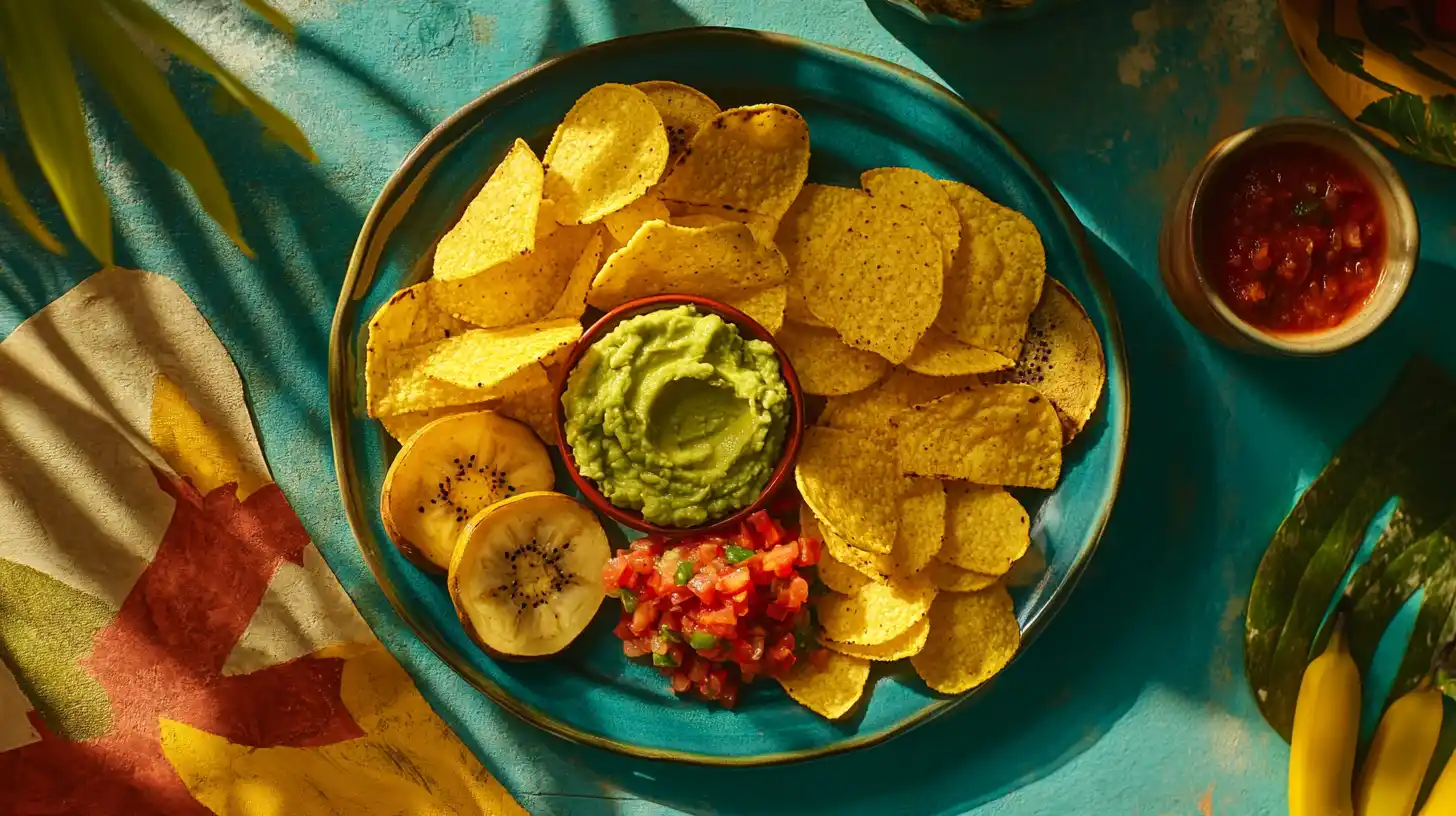
Crispy Plantain Chips
Equipment
- Knife
- Mandoline Slicer (optional)
- Baking Sheet or Frying Pan
Ingredients
Plantain Chips Ingredients
- 2 green plantains unripe for crispier chips
- 2 tbsp olive oil or coconut oil for baking; use vegetable or peanut oil for frying
- salt to taste
- spices optional: smoked paprika, garlic powder, chili powder
Instructions
- Preheat your oven to 375°F (190°C) if baking.
- Peel the plantains by cutting off the ends and scoring the skin lengthwise. Remove the peel carefully.
- Slice the plantains into thin, even rounds using a knife or mandoline slicer.
- Toss the plantain slices in oil and season with salt and optional spices.
- If baking, spread the slices in a single layer on a baking sheet and bake for 15-20 minutes, flipping halfway through.
- If frying, heat oil in a pan and fry the slices until golden brown, about 2-3 minutes per side. Drain on paper towels.
- Let cool and enjoy your crispy plantain chips!
